The Peninsula
Low Youth Employment in Korea Part 2: The Challenges of Labor and Product Market Dualism

This is the second in a two-part series looking at youth employment in Korea. Part 1 can be found here.
Korea’s low youth employment rate reflects the mismatch between the education system and the labor market. The mismatch is driven in part by young people’s pursuit of higher education in hopes of obtaining a “Golden Ticket” — a regular job in a large company or the public sector. Such a career provides higher wages, better coverage by social insurance and job security. Consequently, young people queue for such jobs while small and medium-sized enterprises (SMEs) face significant labor shortages. The effectiveness of government policies to boost youth employment is limited because they do not address the fundamental problem – a lack of attractive jobs. Increasing youth employment requires overcoming labor market dualism (the large gap in wages and social benefits between regular and non-regular workers) and product market dualism (the large wage and productivity gap between large firms and SMEs).
Labor market dualism
The large gap between regular and non-regular workers
Dualism is deeply entrenched in Korea’s labor market. Non-regular employment, which includes fixed-term (temporary), part-time and atypical workers, accounted for 42% of employment in 2021. The incidence of non-regular employment is highest among persons aged 60 and above, who are pushed out of career jobs by mandatory retirement, and youth (Figure 1). Indeed, 45% of young female employees and 39% of young male employees were non-regular in 2021. Regular workers receive higher wages and social insurance coverage and strong employment protection. Non-regular workers receive lower wages, are less likely to be enrolled in social insurance and work in precarious jobs. While only 2.4% of permanent employees left their jobs in 2016, 18.8% of temporary and daily workers did so. About two-thirds of non-regular workers are fixed-term. Consequently, the share of temporary employment in Korea was 26% in 2020, the second highest in the OECD and more than double the 11% OECD average.
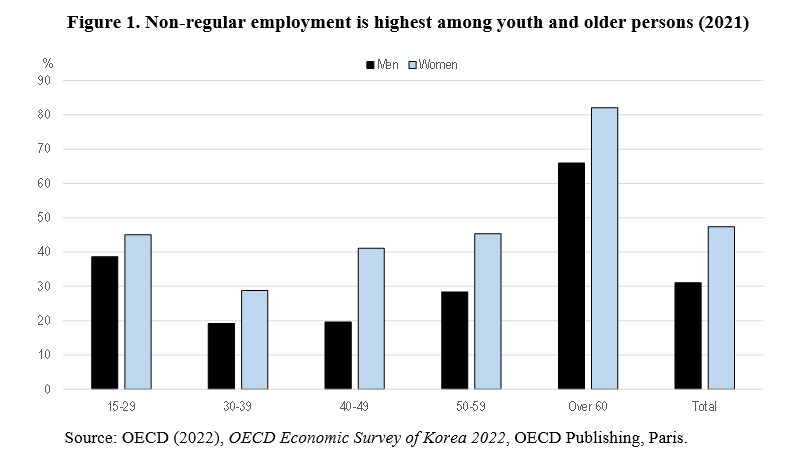
In 2020, the hourly wage of non-regular workers was only 72% of that of regular workers (Figure 2, Panel A). The earnings gap is even more significant in practice, as 62% of regular workers received company bonus payments, which account for around a quarter of annual earnings, compared to 21% of non-regular workers (Figure 2, Panel B). Given Korea’s seniority-based wage system, fixed-term workers are penalized for their relatively short tenure. However, the large wage gap is inconsistent with employees’ skill levels. The OECD’s 2013 Survey of Adult Skills found that the literacy skills of temporary workers in Korea were equivalent to those of permanent workers in the 25-64 age group and even higher among those aged 16 to 24.
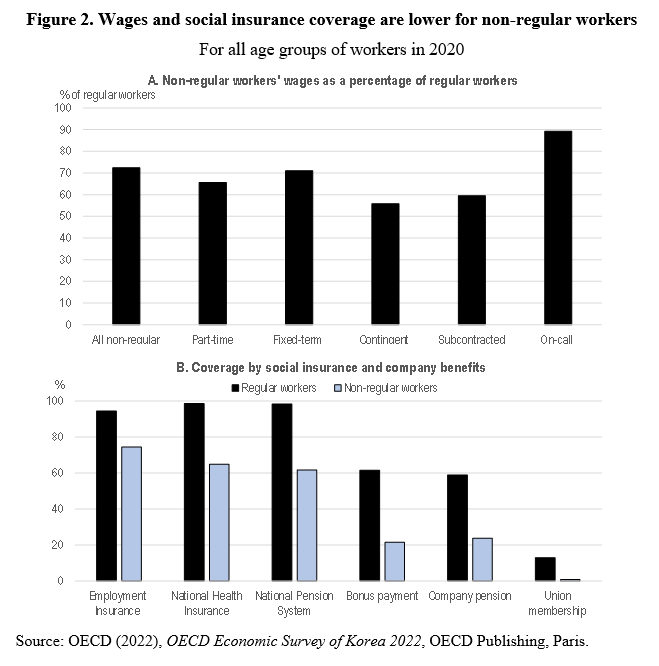
Coverage by social insurance is lower for non-regular workers. The share of non-regular workers enrolled in the National Pension System (62%), National Health Insurance (65%) and Employment Insurance (74%) in 2020 was well below the more than 90% for regular workers despite government subsidies for the contributions of low-income workers (Figure 2, Panel B). Moreover, less than a quarter of non-regular workers were enrolled in company pension systems compared to 59% of regular workers. Finally, less than 1% of non-regular workers belong to labor unions compared to 13% of regular workers and more than one-third of regular workers in large firms. Unions’ focus on the interests of regular employees has strengthened the dualization of the labor market.
Completing tertiary education reduces the possibility of ending up as a non-regular worker. In 2017, more than 70% of graduates from college (generally a two-year program) and university (a four-year program) were employed as regular workers, compared to less than 40% of high school graduates (Figure 3). Given the higher wages for regular workers, only 12% of university graduates were in the lowest income quartile in 2017, while 38% were in the highest quartile. In contrast, nearly half of high school graduates were in the lowest income quartile. The limited opportunities to move from non-regular to regular employment in Korea’s segmented labor market further increases the importance attached to tertiary education.

Breaking down labor market dualism
Despite government policies to address labor market dualism, the share of non-regular workers continues to increase. Breaking down dualism requires addressing the fundamental factors that encourage firms to hire non-regular workers. Government surveys of employers report that they hire non-regular workers to ensure labor market flexibility over the business cycle, thereby avoiding the high cost of laying off regular workers. A second reason for hiring non-regular workers is their lower labor costs, due in part to their lower enrolment rate in social insurance. Breaking down labor market dualism requires a comprehensive strategy of relaxing employment protection for regular workers and increasing the enrolment rate in social insurance and training for non-regular workers.
Regular workers are protected from dismissal by labor laws, court decisions, business practices, social customs and labor unions. The high dismissal cost is accompanied by uncertainty about long and complex court rulings. Furthermore, Korea has a high frequency of reinstatement orders in cases of unfair dismissals. Consequently, the share of permanent workers laid off in 2016 was only 0.4%, compared to 14.2% for temporary and daily workers.
Product Market Dualism
The wide productivity and wage gap between SMEs and large firms
Korean SMEs – defined as firms with less than 300 employees – accounted for 80% of business-sector employment in 2016, the second highest share in the OECD, and well above Japan (53%) and the United States (42%). However, productivity in Korean SMEs is only one-third of that in large firms compared to the OECD average of over one-half (Figure 4). This is linked to low service productivity, given that SMEs account for about 90% of service-sector employment.
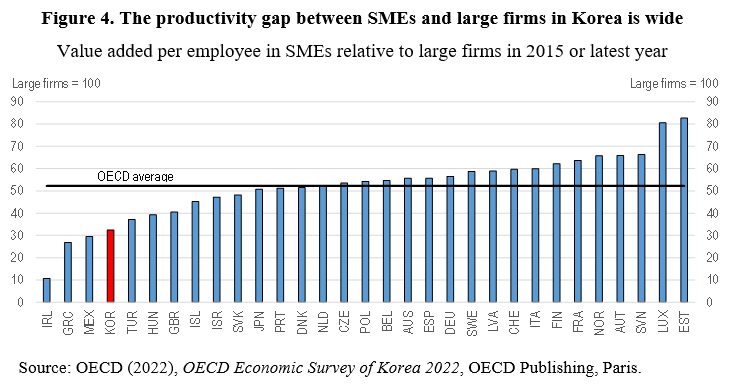
In addition to holding back economic growth, the sizable sectoral productivity gap exacerbates wage inequality. Wages paid to young employees by firms with at least 300 employees are 50% higher than those paid in firms with less than ten employees (Figure 5). The gap widens to 140% among workers aged 55 to 64. Low productivity makes it difficult for SMEs to offer the well-paid regular jobs demanded by high-skilled workers. SMEs are trapped in a vicious circle; they face labor shortages because of their low productivity and wages and end up with a large share of less-skilled workers, typically non-regular, preventing SMEs from raising productivity and wages. Indeed, the share of non-regular workers was 48% at firms with less than five workers, 32% at those with five to 300, but declines to14% at large firms (those with more than 300 workers).
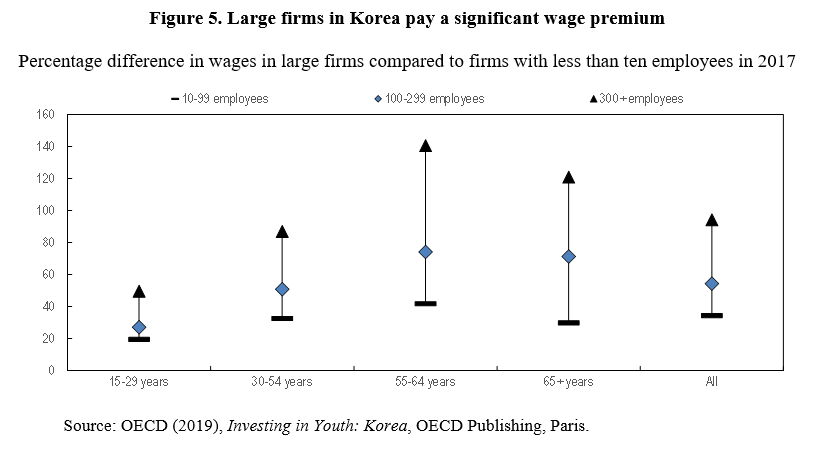
Given the lower wages, only 4% of young people want to work at an SME, according to a 2021 government survey of people aged 13 to 34 (Figure 6, Panel A). Many SMEs employees face a “double penalty”: a high risk of being a non-regular worker and being paid less than non-regular workers in large firms. Nearly two-thirds of young people hope to work at large firms, government agencies or public companies. The probability of working at a large company rises with educational attainment, further fuelling the drive for tertiary education. In 2017, 38% of workers with a master’s degree or higher worked in companies with at least 300 employees, compared to only 10% and 6% for college and high school graduates, respectively (Figure 6, Panel B). In contrast, 86% of high school graduates worked in firms with less than 100 workers. Tertiary graduates who are initially unsuccessful in obtaining a job in the public sector or large companies tend to queue for such jobs rather than fill labor shortages at SMEs.
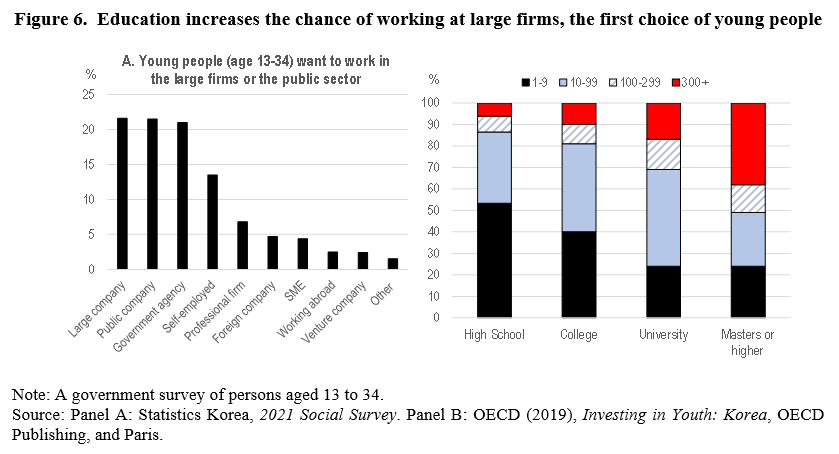
Breaking down product market dualism
Youth employment is likely to depend increasingly on SMEs. During Korea’s high-growth era, job creation was driven by large firms, notably those associated with the large business groups (known as chaebols). However, large firms are increasingly internationalized, have shifted to a more capital and technology-intensive product mix and rely more on outsourcing. Innovative SMEs and start-ups are increasingly the primary source of youth employment. Increasing the employment of young people thus depends to a large extent on making the SME sector more dynamic through a range of policies:
- Improving innovation by SMEs, which tends to lag behind large firms due to inadequate funds to invest in R&D and a lack of human resources.
- Reforming the high level of public support for SMEs, which has been found to lower the productivity of recipient firms and increase the survival probability of incompetent ones.
- Reducing the regulatory burden, which is the sixth-most stringent among OECD countries, and impinges more heavily on services. This has adverse impacts on SMEs, given their concentration in services.
- Expanding market-based financing for SMEs while moving away from collateralized loans.
- Promoting opportunities for entrepreneurship, which ranks low in Korea in terms of the perceived ease of starting a business and opportunities for entrepreneurship.
- Preventing unfair practices by chaebols, particularly in the area of subcontracting.
- Expanding training opportunities for SME employees.
Conclusion
Boosting youth employment requires changing the education system (Part 1) and fundamental economic reform to reduce dualism. Labor market dualism is linked to the dualism between large firms and SMEs, and youth employment cannot be increased in a sustainable way without addressing this polarization. Increasing youth employment is essential for Korea’s economic vitality and the young people concerned. In addition, better labor market outcomes for young workers would promote family formation and raise Korea’s fertility rate from its extremely low level of 0.81.
This article is based on Chapter 3 of the 2022 OECD Economic Survey of Korea, which was prepared by Randall S. Jones.
Randall S. Jones is a Non-Resident Distinguished Fellow at the Korea Economic Institute of America. The views expressed here are the author’s alone.
Photo from Craig Rohn’s photostream on flickr Creative Commons.
